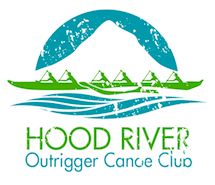
Vocabulary
The Change: Seat 3 will usually call the change with an audible 'Hut' and two strokes later the crew will transition their paddles to the other side, making sure the first four strokes are hard and powerful.
'hut': What you will hear seat 3 call out at the top of a stroke, just as your blade enters the water, to let the crew know the change is about to happen. Sometimes you will hear a "HO" on the next stroke to confirm the change is coming.
Paddles Up/ Let Her Run: Stop paddling.
Timing: Timing is the most important component to this sport for speed and glide! Your paddle and your body motion should exactly match the timing and body movement of the crew members in front of you.
huli: This is when the canoe flips upside down. Every seat has a responsibility to get the canoe up right. Seat 1 will collect Seat 2's paddle and watch the bow. Seat 5 will collect Seat 4's paddle and get to the non-Ama side. Seat 2 and 4 climb over the hull, grab the iakos and pull the hull back upright, gently setting the Ama back into the water. Seat 6, the steers person, will count heads, and assist where needed. One person will get in to start bailing water followed by the rest of the crew. Crew climb back into the canoe from the Ama side only.
kahi: This means to “cut” in Hawaiian. It is a stroke technique that is used to move one end of the canoe sideways or quickly turn the canoe. You reach out your paddle far to the side, put your blade into the water and pull the canoe towards your blade, pushing the water UNDER the canoe. Usually ONLY seat 1 does this on the Steers request.
une: This means to "lever." Seat 1, the stoker and sometimes others will poke the paddle at an angle against the right side of the canoe to help move the bow of the canoe to the left in a buoy or fast turn. Seat 2 may kahi at same time.
Race Start: The steers in seat 6 will call out, “READY SET HIT!” Together all paddles enter the water in a strong catch right after HIT. Strong, clean first strokes building to level 3 for four power tens.
Level 1 paddling: a casual, slow paddle, used in warm up, technique practice and long endurance training to enhance muscle memory of correct technique.
Level 2 paddling: a strong, fast, smooth paddle that you can continue for a long period.
Level 3 paddling: your top race speed and power maintaining good technique and timing. Giving it your ALL!!!
“Two Up”: Power up the stroke to a level 3 for 2 sets of 10.
“Four Up”: Power up the stroke to a level 3 for 4 sets of 10
ama - the float on a outrigger canoe. And a paddler ALWAYS leaves the canoe on the Ama side, so the canoe DOES NOT hull!
i'ako - arched crossbeams which fasten the floater (Ama) to the hull of an outrigger canoe.
'ohana - family
hale' - house
Team Cowboy: Scheduling platform used by HROCC uses for event sign up
REMINDER: We are all here to have fun and practice Ohana in the beautiful Columbia Gorge. Outrigger paddling is a wonderful experience when you finally get your stroke technique down and understand how a crew works together. Once you experience the incredible and elusive glide of a well timed, in sync boat, you will be hooked!
Next Page: Paddler Etiquette & Responsibilities